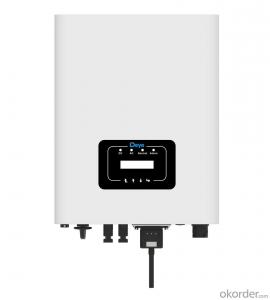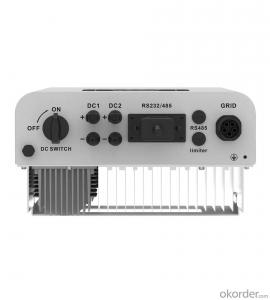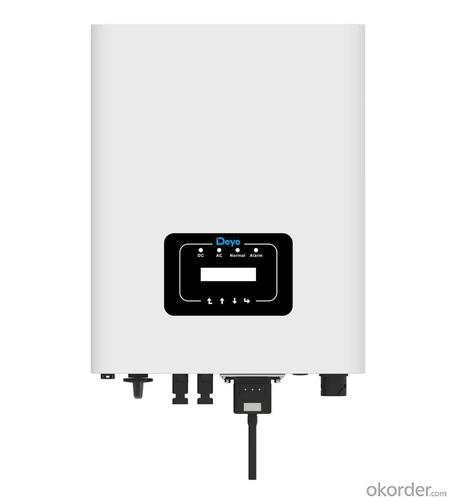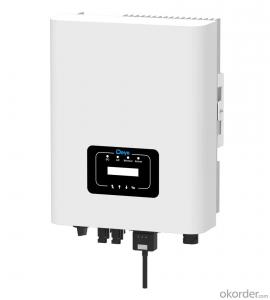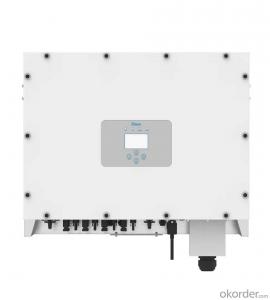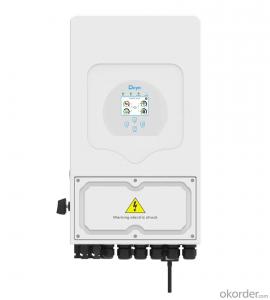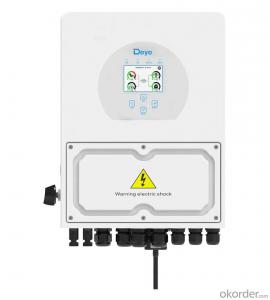SPD for Solar Inverter - Sun-4/5/6/7/8/10/12k-G05 | 4-12kW | Three Phase | 2 MPPT
- Loading Port:
- Ningbo
- Payment Terms:
- TT OR LC
- Min Order Qty:
- 100 pc
- Supply Capability:
- 5000 pc/month
OKorder Service Pledge
OKorder Financial Service
You Might Also Like
Specification
| Technical Data | |||||||||
| Model | SUN-4K-G05 | SUN-5K-G05 | SUN-6K-G05 | SUN-7K-G05 | SUN-8K-G05 | SUN-10K-G05 | SUN-12K-G05 | ||
| Input Side | |||||||||
| Max. DC Input Power (kW) | 5.2 | 6.5 | 7.8 | 9.1 | 10.4 | 13 | 15.6 | ||
| Max. DC Input Voltage (V) | 1000 | ||||||||
| Start-up DC Input Voltage (V) | 140 | 250 | |||||||
| MPPT Operating Range (V) | 120~850 | 200~850 | |||||||
| Max. DC Input Current (A) | 13+13 | ||||||||
| Max. Short Circuit Current (A) | 19.5+19.5 | ||||||||
| No.of MPP Trackers | 2 | ||||||||
| No.of Strings per MPP Tracker | 1 | ||||||||
| Output Side | |||||||||
| Rated Output Power (kW) | 4 | 5 | 6 | 7 | 8 | 10 | 12 | ||
| Max. Active Power (kW) | 4.4 | 5.5 | 6.6 | 7.7 | 8.8 | 11 | 13.2 | ||
| Nominal Output Voltage / Range (V) | 3L/N/PE 380V/0.85Un-1.1Un, 400V/0.85Un-1.1Un | ||||||||
| Rated Grid Frequency (Hz) | 50 / 60 (Optional) | ||||||||
| Operating Phase | Three phase | ||||||||
| Rated AC Grid Output Current (A) | 5.8 | 7.2 | 8.7 | 10.1 | 11.6 | 14.5 | 17.4 | ||
| Max. AC Output Current (A) | 6.4 | 8 | 9.6 | 11.1 | 12.8 | 15.9 | 19.1 | ||
| Output Power Factor | 0.8 leading to 0.8 lagging | ||||||||
| Grid Current THD | <3% | ||||||||
| DC Injection Current (mA) | <0.5% | ||||||||
| Grid Frequency Range | 47~52 or 57~62 (Optional) | ||||||||
| Efficiency | |||||||||
| Max. Efficiency | 98.3% | ||||||||
| Euro Efficiency | 97.5% | ||||||||
| MPPT Efficiency | >99% | ||||||||
| Protection | |||||||||
| DC Reverse-Polarity Protection | Yes | ||||||||
| AC Short Circuit Protection | Yes | ||||||||
| AC Output Overcurrent Protection | Yes | ||||||||
| Output Overvoltage Protection | Yes | ||||||||
| Insulation Resistance Protection | Yes | ||||||||
| Ground Fault Monitoring | Yes | ||||||||
| Anti-islanding Protection | Yes | ||||||||
| Temperature Protection | Yes | ||||||||
| Integrated DC Switch | Yes | ||||||||
| Remote software upload | Yes | ||||||||
| Remote change of operating parameters | Yes | ||||||||
| Surge protection | DC Type II / AC Type II | ||||||||
| General Data | |||||||||
| Size (mm) | 330W×457H×185D | 330×457×205 | |||||||
| Weight (kg) | 10 | 11 | |||||||
| Topology | Transformerless | ||||||||
| Internal Consumption | <1W (Night) | ||||||||
| Running Temperature | -25~65℃, >45℃ derating | ||||||||
| Ingress Protection | IP65 | ||||||||
| Noise Emission (Typical) | <30 dB | ||||||||
| Cooling Concept | Natural cooling | ||||||||
| Max. Operating Altitude Without Derating | 2000m | ||||||||
| Warranty | 5 years | ||||||||
| Grid Connection Standard | CEI 0-21, VDE-AR-N 4105, NRS 097, IEC 62116, IEC 61727, G99, G98, VDE 0126-1-1, RD 1699, C10-11 | ||||||||
| Operating Surroundings Humidity | 0-100% | ||||||||
| Safety EMC / Standard | IEC/EN 61000-6-1/2/3/4, IEC/EN 62109-1, IEC/EN 62109-2 | ||||||||
| Features | |||||||||
| DC Connection | MC-4 mateable | ||||||||
| AC Connection | IP65 rated plug | ||||||||
| Display | LCD1602 | ||||||||
| Interface | RS485/RS232/Wifi/LAN | ||||||||
· 2 MPP tracker, Max. efficiency up to 98.3%
· Zero export application, VSG application
· String intelligent monitoring (optional)
· Wide output voltage range
· Anti-PID function (Optional)
SUN-4/5/6/7/8/10/12K-G05 | 4-12KW | Three Phase | 2 MPPT
Higher yields / Safe & Reliable / Smart / User-friendly
This series inverter is specially designed for three-phase PV systems, covering a wide power range of 4kW, 5kW, 6kW, 7kW, 8kW, 10kW, 12kW. With compactness design, it is easy to install and operate. It supports wide AC output voltage to ensure longer working hour.
- Q: What are the different types of solar inverters?
- There are three main types of solar inverters: string inverters, microinverters, and power optimizers.
- Q: Is the grid side of the grid and the inverter?
- Grid-type system power transmission sequence: photovoltaic panels> relays> inverters> relays> electricity load + power grid (both in parallel).
- Q: What is the typical installation process for a solar inverter?
- The typical installation process for a solar inverter involves several steps. First, a suitable location for the inverter is identified, usually near the solar panels. The inverter is then mounted securely on a wall or other structure. Next, the DC wiring from the solar panels is connected to the input terminals of the inverter, ensuring proper polarity. The AC output terminals of the inverter are then connected to the electrical panel of the building, often through a dedicated circuit breaker. Finally, the inverter is connected to the monitoring system to track its performance and ensure optimal energy production. It is important to follow the manufacturer's instructions and consult a professional electrician to ensure a safe and efficient installation.
- Q: Can a solar inverter be used with different tracking algorithms?
- Yes, a solar inverter can be used with different tracking algorithms. Inverters are designed to convert the DC power generated by solar panels into AC power for use in homes and businesses. They typically have the ability to integrate with various tracking algorithms that optimize solar panel performance by adjusting their position and angle according to the sun's movement. This flexibility allows for increased energy production and efficiency based on the specific tracking algorithm used.
- Q: Can a solar inverter be used in areas with high dust and dirt accumulation?
- Yes, a solar inverter can be used in areas with high dust and dirt accumulation, but it is important to take certain precautions and maintenance measures to ensure its proper functioning. Dust and dirt can accumulate on the surface of the solar panels, reducing their efficiency over time. This can also affect the performance of the solar inverter since it relies on the energy generated by the solar panels. To mitigate the impact of dust and dirt, regular cleaning of the solar panels is essential. This can be done by using a soft brush or sponge and mild detergent mixed with water. It is important not to use abrasive materials or excessive water pressure, as this can damage the panels. Additionally, installing the solar panels at an angle and positioning them to face the sun can help in reducing the accumulation of dust and dirt. Moreover, some solar inverters are designed with built-in protection against dust and dirt. These inverters usually have IP65 or higher ratings, which means they are dust-tight and can withstand water jets. Choosing such inverters can provide an added layer of protection against the adverse effects of dust and dirt accumulation. Overall, while a solar inverter can be used in areas with high dust and dirt accumulation, regular maintenance and proper cleaning of the solar panels are crucial to ensure optimal performance and longevity of the system.
- Q: Can a solar inverter be used with solar-powered outdoor lighting?
- Yes, a solar inverter can be used with solar-powered outdoor lighting. A solar inverter is responsible for converting the DC (direct current) electricity produced by solar panels into AC (alternating current) electricity that can be used to power various devices, including outdoor lighting systems. This allows the solar-powered outdoor lighting to function efficiently and effectively.
- Q: Can a solar inverter be used with different communication protocols?
- Yes, a solar inverter can be used with different communication protocols. Many modern solar inverters are designed to be compatible with various communication protocols such as RS485, Modbus, Ethernet, or Wi-Fi. This allows for flexibility in integrating the inverter with different monitoring systems or smart home automation platforms.
- Q: Are there any government incentives for installing solar inverters?
- Yes, there are government incentives for installing solar inverters. In many countries, governments offer tax credits, rebates, grants, and other financial incentives to promote the adoption of renewable energy technologies, including solar inverters. These incentives aim to reduce the upfront costs of installation and make solar energy more affordable and accessible to individuals and businesses.
- Q: Can a solar inverter be used with a solar-powered heating system?
- Yes, a solar inverter can be used with a solar-powered heating system. The solar inverter is responsible for converting the direct current (DC) generated by the solar panels into alternating current (AC) that can be used to power various appliances, including a heating system. By connecting the solar inverter to the solar panels and then to the heating system, the electricity produced by the solar panels can be utilized to power the heating system, making it more energy-efficient and cost-effective.
- Q: Are there any voltage or frequency regulations for solar inverters?
- Solar inverters are subject to voltage and frequency regulations, which differ depending on the country and are typically established by regulatory bodies or standardization organizations. To ensure the safe and reliable operation of the electrical grid, solar inverters in most countries must adhere to specific voltage and frequency limits. Voltage regulations dictate the permissible range of output voltage that a solar inverter can supply to the grid. This guarantees that the voltage remains within acceptable boundaries, preventing damage to electrical equipment or disturbances in grid stability caused by overvoltage or undervoltage conditions. The specific voltage limits are influenced by factors such as the type of grid system (e.g., single-phase or three-phase) and the voltage levels employed in the country. In contrast, frequency regulations establish the acceptable range of output frequency that a solar inverter can provide to the grid. The grid frequency is typically set at a specific value (e.g., 50 Hz or 60 Hz), and solar inverters must synchronize their output frequency with the grid to ensure compatibility. Deviations from the specified frequency can result in equipment malfunctions or grid instability. Compliance with voltage and frequency regulations is essential for solar inverters to facilitate the effective integration of renewable energy sources into the electrical grid. In numerous countries, solar inverters must meet specific technical standards or certifications to demonstrate their adherence to these regulations. These standards typically encompass various aspects of inverter performance, including voltage and frequency control, power quality, and interaction with the grid.
Send your message to us
SPD for Solar Inverter - Sun-4/5/6/7/8/10/12k-G05 | 4-12kW | Three Phase | 2 MPPT
- Loading Port:
- Ningbo
- Payment Terms:
- TT OR LC
- Min Order Qty:
- 100 pc
- Supply Capability:
- 5000 pc/month
OKorder Service Pledge
OKorder Financial Service
Similar products
Hot products
Hot Searches
Related keywords
